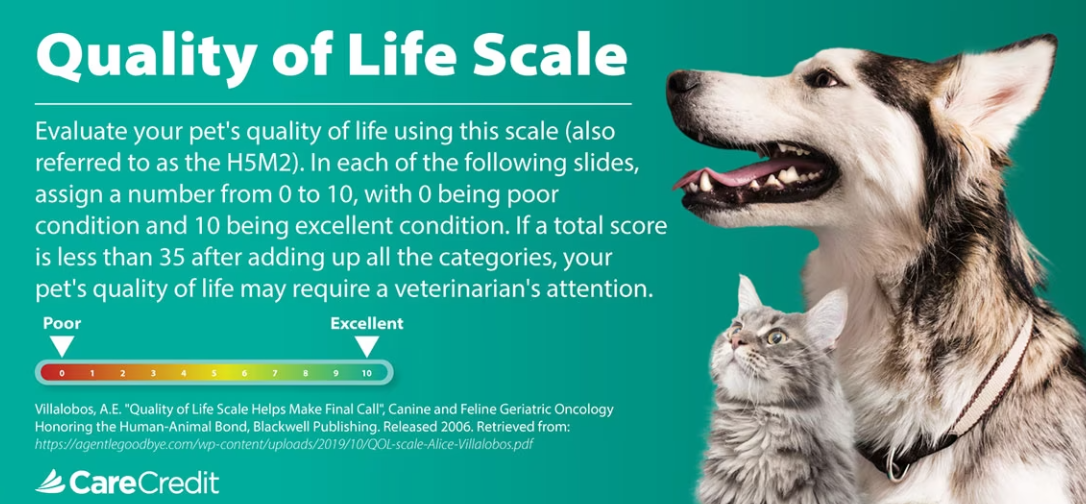Pet Euthanasia: From a Veterinarian’s Perspective

Table of Contents
Saying goodbye to a pet is one of the hardest things we must do as pet parents. For pets that are aging, ill, or in serious pain, sometimes the best option we can provide them is peaceful and humane end-of-life care.
Considering euthanasia for your pet can be an extremely difficult concept to think about and an even harder decision. I hope this post will help guide you on when it's the right time for your pet to cross over the rainbow bridge.
We realize how deeply emotional this process is for pet parents, and we consider it an honor to help with your pet’s transition. Our team is always here for support to help you make the best choice for your pet and process the loss of a beloved member of your family.
What is Pet Euthanasia?
Pet euthanasia is the process of painlessly and humanely assisting a pet to pass away. While this procedure can become necessary as a pet ages naturally, it can also result from an illness or injury that seriously reduces their quality of life.
It may not always be obvious that a pet is suffering or in pain, so it's important to understand the signs that your pet is telling you.
When to Consider Euthanasia
Pets are assessed on a Quality-of-Life scale, which helps a pet parent and veterinarian assess their overall functioning. When a pet's quality of life declines to the point where they are no longer comfortable or mobile with day-to-day functioning, this is a sign it might be time to consider palliative care options.
Keep reading: Compassionate Cat Hospice Care: Creating Comfort at Home

Typically, when a pet is nearing the end of their life, they will experience some or all of the following:
- A loss of interest in favorite activities or foods
- Becoming less responsive than usual
- Being excessively tired and spend most of the day sleeping or lying down
- Showing signs of pain, including limping, whimpering, or listlessness
If you are unsure of your pet's condition, it's best to have a quality-of-life assessment performed by a qualified veterinarian. We are trained to evaluate pets for signs of decline and can help clarify how they are doing and feeling.
The Humane Euthanasia Process, Explained
It's common to worry that your pet will know what's happening or will feel pain. Knowing what to expect can be helpful and alleviate some of your concerns. Pet parents can take comfort in knowing that euthanasia is a peaceful and painless process.
- During the euthanasia procedure, an experienced veterinarian will first administer a sedative to help your pet to become deeply relaxed.
- You are welcome to stay with your pet during the entire process, holding them and talking to them.
- Your veterinarian will then administer a second injection that will stop their heart.
- Pets will gradually slip into unconsciousness, much like a deep sleep, and pass away shortly afterward.
Benefits of In-Home Euthanasia
- In-home pet euthanasia services allow pets to cross the rainbow bridge at home, surrounded by love.
- Humane euthanasia at home enables our veterinarians to pace the appointment according to your comfort level.
- Our in-home appointments allow for extra time to spend with your pet in their final moments, and you can choose to have as many family members present as you want.
This is a deeply personal choice, so only you know which is the best option for you and your family. If you are not sure what to do, please reach out.
A consultation with your veterinarian will help clarify what is best for your pet.
Grieving the Loss of a Pet
Common Emotions
Coping with losing a pet can take a long time. Pet parents can expect to feel a wide range of emotions in the aftermath of loss, especially after the difficult decision to go forward with euthanasia. Powerful feelings can include:
- Shock
- Denial
- Anger
- Bargaining
- Depression
Aftercare Options and Memorials for Pets
After your pet's passing, you may choose to process your loss by holding a memorial service in honor of your pet. Memorializing a beloved pet with cremation services or a burial are both options, depending on your wishes.
Emotional Support and Resources for Pet Parents
After the loss of a pet, you may want to reach out to support groups for pet loss or explore some helpful resources, such as the Association for Pet Loss and Bereavement. Pet loss support groups on Facebook or Reddit have been meaningful to many pet parents.
Conclusion
Making the decision to euthanize a pet is the hardest choice a pet parent can make. If you decide to move forward with a plan for pet hospice care or humane euthanasia in the best interest of your pet, our veterinarians can provide a peaceful service in the familiar environment of your home, as well as provide guidance and support every step of the way.
Cherishing the Bond With Your Pet Until Very End
BetterVet doctors offer in-home euthanasia, ensuring a peaceful and familiar setting for your pet’s final moments.
Frequently Asked Questions
How do I know it's time to consider euthanasia for my pet?
If your pet is suffering from a serious decline in quality of life, it may be time to consider humane euthanasia. This is best evaluated by a veterinarian during an in-home Quality-of-Life or Euthanasia Consultation.
What are the options for aftercare following euthanasia?
Aftercare options for pets can include cremation or burial. Some pet parents prefer to keep their pet's ashes in their home; others may want to visit a gravesite instead. It's a deeply personal choice.
Is in-home euthanasia better for my pet?
Allowing a pet to cross the rainbow bridge in the comfort of home generally allows for a more peaceful experience for both you and your pet.
How can I cope with the loss of my pet after euthanasia?
Coping with the loss of a pet can be difficult, so allowing yourself time to grieve is important. If you are struggling to cope, seek out support groups or services to help you process your loss.
What should I tell my children about pet euthanasia?
Be up-front about euthanasia in an age-appropriate way, keeping in mind that young children may not fully understand. I suggest avoiding euphemisms and explaining that their pet was in pain and has gone to a peaceful place. Educational children's books about euthanasia can also be helpful.






